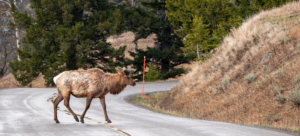New Mexico Legislature Misses Opportunity to Fund Wildlife Crossings
Investing in reducing wildlife-vehicle collisions can save lives and protect species
Media Contacts:
Garrett VeneKlasen, New Mexico Wild, (505) 670-2925, garrett@nmwild.org
Michael Dax, Wildlands Network, (518) 598-3442, michael@wildlandsnetwork.org
Bryan Bird, Defenders of Wildlife, (505) 501-4488, bbird@defenders.org
Jesse Deubel, New Mexico Wildlife Federation, (505) 440-2621, jesse@nmwildlife.org
Albuquerque, NM (March 5, 2024) – The New Mexico Legislature concluded on Thursday, February 15 with $5 million allocated towards wildlife crossings. Despite the state being a leader on wildlife crossings, sportsmen and conservation groups were disappointed to see the legislative session close without a $50 million appropriation that would attract federal matching dollars with funding needs estimated to be about $388 million to address the eleven priority areas identified by the New Mexico Department of Transportation.
In 2021, Governor Michelle Lujan Grisham spearheaded this leadership by signing an executive order which expanded the state’s efforts to fund wildlife crossing solutions, among other efforts. The state also allocated funding during the 2023 legislative session and has leveraged funds from the federal bipartisan infrastructure package’s Wildlife Crossings Pilot Program, which grants money to states to build wildlife crossing solutions.
“New Mexico has been at the forefront of addressing the challenges modern infrastructure presents to the state’s wildlife,” said Marcel Gaztambide, Southwest Field Manager, Theodore Roosevelt Conservation Partnership. “The state’s leadership has resulted in the construction of wildlife corridors, which we applaud, and hope that greater funding will be prioritized to expand the construction of such effective measures that can bolster New Mexico’s conservation success.”
Gov. Lujan Grisham also signed the Wildlife Corridors Act into law in 2019, which identifies wildlife-vehicle collision hotspots, areas that are high risk for drivers and administer reduced speed limits. Numerous hotspots, along with the areas noted below, have been identified
– U.S. 550 North of Cuba
– U.S. 180 and NM 90 near Silver City
– U.S. 70 and NM 48 in Ruidoso
– I-25 on Glorieta Pass
– U.S. 70 in the Bent Sacramento Mountains
The hotspots are also evident in the estimated 1,200 wildlife collisions reported annually by the state, resulting in nearly $20 million in property damage, emergency response, and health care costs. However, the number is likely higher, with collision rates potentially being four to five times more than reported.
“With so many wildlife-vehicle collision hotspots in New Mexico, we need a far larger financial commitment in future years,” said Bryan Bird, Southwest program director for Defenders of Wildlife. “It’s encouraging to see the state putting some funds on the table for safe highways and wildlife passage.”
Nationally, wildlife-vehicle collisions exceed $8 billion. Whereas, building wildlife crossings can range from $250,000 to $600,000 for a large mammal underpass to approximately $7 million for a double span overpass. Research shows that such life-saving infrastructure pays for itself in a relatively short amount of time.
The research also shows that wildlife crossings are an effective solution that can reduce wildlife-vehicle collisions by up to 92%. These life-saving projects offer the state legislature the opportunity to invest in these measures and further advance New Mexico’s leadership on wildlife crossings.
“New Mexico’s wildlife defines the land’s history and is critical to the ecosystem. However, our modern roadways interrupt their migration, resulting in dangerous wildlife-vehicle collisions,” said Jesse Deubel, Executive Director, New Mexico Wildlife Federation. “As New Mexican sportsmen and women, we cherish the heritage of the wildlife and hope to see our state leaders commit more substantial funding for wildlife corridors to protect these species for generations to come.”
Historic amounts of federal funding are available to states from the Biden administration to build wildlife corridors. There is also support at the state level with Gov. Lujan Grisham and Representative Nathan Small supporting the construction of wildlife corridors. While this support and federal funding opportunities exist, infrastructure in the state is expanding rapidly, and increasingly in areas where wildlife are present, presenting a public safety hazard. For this reason, sportsmen and conservationists are urging leaders to prioritize this threat and put forth significant funding in the next legislative session for effective measures, like wildlife corridors that protect both people and wildlife.


